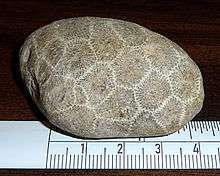Petoskey stone

Petoskey stone is a rock and a fossil, often pebble-shaped, that is composed of a fossilized rugose coral, Hexagonaria percarinata.[1] The stones were formed as a result of glaciation, in which sheets of ice plucked stones from the bedrock, grinding off their rough edges and depositing them in the northwestern (and some in the northeastern) portion of Michigan's lower peninsula. In those same areas of Michigan, complete fossilized coral colony heads can be found in the source rocks for the Petoskey stones.
Petoskey stones are found in the Gravel Point Formation of the Traverse Group. They are fragments of a coral reef that was originally deposited during the Devonian period.[1] When dry, the stone resembles ordinary limestone but when wet or polished using lapidary techniques, the distinctive mottled pattern of the six-sided coral fossils emerges. It is sometimes made into decorative objects. Other forms of fossilized coral are also found in the same location.
In 1965, it was named the state stone of Michigan.
Etymology

The name comes from an Ottawa Indian Chief, Chief Pet-O-Sega. The city of Petoskey, Michigan, is also named after him, and is the center of the area where the stones are found. The stones are commonly found on beaches and in sand dunes.
According to legend, Petosegay was a descendant of French nobleman and fur trader, Antoine Carre and an Ottawa princess. Petosegay, meaning "rising sun", "rays of dawn" or "sunbeams of promise", was named after the rays of sun that fell upon his newborn face. In keeping with his promising name, Petosegay was a wealthy fur trader who gained much land and acclaim for himself and his tribe. He was remarked upon to have a striking and appealing appearance, and spoke English very well. He married another Ottawa, and together they had two daughters and eight sons. In the summer of 1873, a few years before the chief's passing, a city began on his land along Little Traverse Bay. The settlers christened the newborn city Petoskey, an anglicized form of Petosegay.[2]
Locations
Petoskey stones can be found on various beaches and inland locations in Michigan, with many of the most popular being those surrounding Petoskey and Charlevoix. The movement of the frozen lake ice acting on the shore during the winters is thought to turn over stones at the shore of Lake Michigan, exposing new Petoskey stones at the water's edge each spring.[3] Petoskey Stones are also commonly found in Iowa, Indiana, Illinois, Ohio, New York, Canada, Germany, England, and even Asia.[4]
On September 23, 2015, it was reported that a 93-pound Petoskey stone was removed from the shallow waters of Lake Michigan, near the city of Northport, Michigan.[5] In December 2015, the Michigan Department of Natural Resources confiscated the stone under a state law that disallows removing more than 25 pounds (11 kg) of materials from state lands.[6]
It is sometimes used as a gemstone.[7]
Photo gallery
- Close view of polished Hexagonaria percarinata from Michigan.
.jpg) Unpolished Petoskey stone about 5.5 in (14 cm) long
Unpolished Petoskey stone about 5.5 in (14 cm) long%2C_Michigan.jpg) Closeup view, field of view ~3.6 cm wide
Closeup view, field of view ~3.6 cm wide
References
- 1 2 Middle Devonian Transverse Group in Charlevoix and Emmet counties, Michigan, Geological Society of America Centennial Field Guide—North-Central Section, Randall L. Milstein, Subsurface and Petroleum Geology Unit, Michigan Geological Survey, Lansing, Michigan, 1987
- ↑ http://www.michigan.gov/documents/deq/ogs-gimdl-GGPS_263213_7.pdf Michigan's official State Stone
- ↑ Petoskey Stone, Petoskey Area Visitors Bureau
- ↑ Michigan Department of Environmental Quality
- ↑ "Man lugs 93-pound Petoskey stone out of Lake Michigan". MLive Michigan. MLive Media Group. Retrieved 23 September 2015.
- ↑ Tunison, John (11 December 2015). "State confiscates 93-pound Petoskey stone from Michigan man". MLive Michigan. Retrieved 11 December 2015.
- ↑ Gemstones of North America, Volume 3, John Sinkankas Van Nostrand, 1959, p.66
- Bruce Mueller and William H. Wilde, 2004, The Complete Guide to Petoskey Stones, The University of Michigan Press ISBN 978-0-472-03028-6
External links
| Wikimedia Commons has media related to Hexagonaria. |